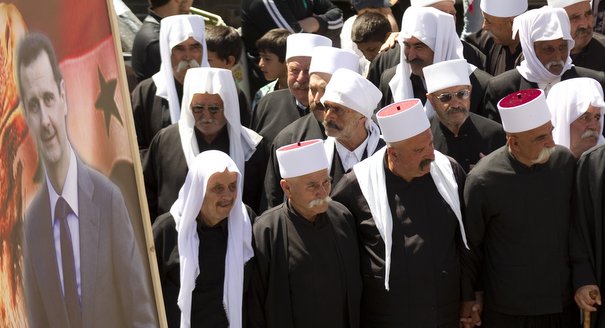The province of Suwayda in southern Syria is the traditional home of the country’s half-million strong Druze community. Here, in the rugged terrain of the Mountain of the Arabs (Jabal al-Arab), the Druze have managed to stave off Sunni persecution and central government for centuries.
The Druze leadership played an important role in expelling French colonialism, but after independence, many resisted the encroaching central government. Given the martial traditions of the Arab Mountain, the military balance was not necessarily in favor of the Syrian Army (in 1945, the Druze leader Sultan Pasha al-Atrash even threatened to occupy Damascus). During Syria’s first decade as an independent state, Syrian governments were constantly preoccupied with the occasionally realized fear of a Druze insurrection and the idea that Jordan might encourage Arab Mountain secession. In 1953–1954, President Adib al-Shishakli even sent the army to occupy the Arab Mountain, massacring scores of villagers in arbitrary artillery barrages. This was to be the start of his downfall in 1954 and the cause of his death in 1964.
With time, the Druze minority was more firmly integrated into Syria’s body politic, with many leading figures co-opted through the army and the Baath Party. Druze officers played a major role in the coups and countercoups of the 1950s and 1960s, but eventually lost influence to the Alawite-dominated officer cliques of Hafez al-Assad and Salah Jadid.
Since then, the Baathist government has worked to keep the Druze community at its side, while systematically repressing any dissenters. Meanwhile, economic and social integration began to set in throughout Syria, dissolving the old tensions. Many Druze moved to Damascus for work or studies; most have settled in the Jaramana neighborhood, in the city’s southeast.
Syria’s Druze Since 2011
During the current uprising, most of Syria’s Druze have kept to the Assad government’s side, like other religious minorities. Obviously, it is not a monolithic community: there are some prominent Druze activists in the opposition, and there seems to be little love for the Assad family. But most Druze appear to fear the opposition more than they do the regime. The threat of sectarian clashes with Sunni rebels in Deraa looms large, and there have been instances of attacks and kidnappings between the communities.
The (shifting) anti-Assad stance of Walid Jumblatt, steward of Lebanon’s Druze community, does not seem to have mattered much, and only very small numbers of Druze have joined the armed uprising. By contrast, many have fought in the ranks of the Syrian Arab Army, and new Druze leaders seem to be emerging through it. The flamboyant Brigadier General Issam Zahreddine, a commander in the Republican Guard, has become a cult figure among some Assad supporters.
The Arab Mountain is now home to a number of pro-government militias. These groups are mostly organized within the National Defense Forces and conceived of as state entities, but their public image is unabashedly sectarian, drawing heavily on Druze symbolism. Some of these forces stand accused of involvement in crime and abuses, and even of attacking Baathist security officers who tried to intervene. But they seem to enjoy the support of leading figures in the Druze community, being the region’s first line of defense against the rising tide of Sunni Islamism in Deraa and Damascus.
Charting Their Own Course?
Gary Gambill, a political analyst of Syria and Lebanon, has argued in a long, fine essay that if Assad’s power continues to wane, the Druze of southern Syria are likely to slowly drift away from his side and instead fortify their hold over the Arab Mountain while seeking out alternative allies in the region. He compares the situation of the Arab Mountain Druze to that of the Kurds in Syria’s far north, where the local Kurdistan Workers’ Party (PKK) affiliates (the PYD and YPG) have plotted their own course since 2011, working opportunistically with both regime and opposition forces, in order to carve out a semi-independent Kurdish region.
There’s little to object to in Gambill’s analysis. It is hard to imagine that many Syrian Druze would want to engage in perpetual war for the sake of Bashar al-Assad once he turns into a liability rather than a useful source of arms and power.
But Gambill’s piece was based on the situation in March 2013. Since then, Assad has regained his footing, at least temporarily. His security and patronage networks in the Arab Mountain are still powerful, and seem able to protect the area from outsiders while also suppressing internal dissent. The fact that a Sunni-Druze conflict is brewing on the border between Suwayda and Deraa (and around the Jaramana neighborhood in Damascus) also makes it difficult for independent-minded Druze leaders to step away from the regime. And the million-lira question remains: Even if they wanted to, are the religious and social elites of the Arab Mountain really strong and unified enough to sideline Baath Party stalwarts within the Druze sect, without triggering devastating internal conflict?






